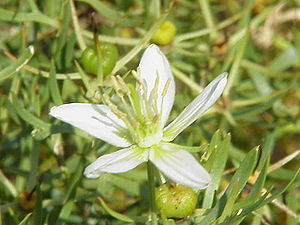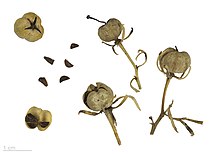Rue
| Rue | ||||||||||||
|---|---|---|---|---|---|---|---|---|---|---|---|---|

Rue ( Peganum harmala ), blossom |
||||||||||||
| Systematics | ||||||||||||
|
||||||||||||
| Scientific name | ||||||||||||
| Peganum harmala | ||||||||||||
| L. |
The steppe rue or Harmel rue ( Peganum harmala ), also called Harmal herb, Syrian rue or African rue, is a species of the genus Peganum within the Nitrariaceae family . It occurs mainly in deserts, semi-deserts and steppes from western Asia to northern India, but occasionally also in the Mediterranean region. Because of the harman alkaloids contained in all parts of the plant , the sedative to narcotic extracts are some of the oldest plant ingredients used as hallucinogens and medicinal products.
Origin of name
The generic name Peganum is derived from the Greek word peganon (the color of the "Peganusian marble" was compared with the color of the diamond in the 8th and 10th / 11th centuries). Dioscurides called peganon the diamond ( wine rue ) and peganon agrion ("wild peganon" or "wild diamond") the harmel diamond, which is not closely related to the diamond.
description
Vegetative characteristics
The rue is a perennial herbaceous plant that reaches heights of 80 to 100 centimeters. The roots are short. The leaves are irregular, pinnately split.
Generative characteristics
The flowering period extends from April to May. The relatively small flowers are white. The cone-shaped fruits contain brown, angular seeds.
distribution
The steppe rue is originally widespread in Mauritania , Spain , Italy , North Africa from Morocco to Egypt , on the Arabian Peninsula, in Eastern and Southeastern Europe and from Western Asia and Pakistan to China and Mongolia .
Systematics
In the past, the genus Peganum was assigned to the zygophyllaceae family .
ingredients
Peganum harmala contains the β-carbolines harmalin , harmine , tetrahydroharmine , related bases such as harmalol and harmidine , as well as the quinazoline alkaloids vasicine , vasicinone and deoxyvasicine . Harmine and harmaline are reversible monoamine oxidase inhibitors (MAOIs).
The outer layer of the seeds contains large amounts of harmine. The highest Harman alkaloid concentrations are found in the seeds of the plant and were estimated in a study to be at least 5.9% (of dry weight). The stems and stems of Peganum harmala contain about 0.36% alkaloids, the leaves about 0.52% and the roots up to 2.5%.
Substance content of the seeds:
- Harmine : 0.44% -1.84% -4.3%
- Harmaline : 0.25% -0.79% -5.6%
- Tetrahydroharmine 0.1%
- Harman : 0.16%
- Harmalol : 0.6% -3.90%
- Vasicin (peganin): 0.25%
- Vasicinone : 0.0007%
- Deoxyvasicine (deoxypeganine):? %
use
Traditional use
The seeds have an intense smell and taste very bitter.
Traditionally used in the Middle East and West Asia for ritual incense, fragrances and as a dye for carpets and wool, the seeds are still often found in Turkish and Iranian cultures under the name Üzerlik (Turkish) or Espand (Persian) or Spilani (Pashto) ) as a versatile budget use.
Use as an entheogen

The seeds are usually consumed orally as part of an ayahuasca analogue due to the MAO inhibition caused by the harman alkaloids they contain . Reversible MAOIs are used to increase or modify the effect of psychoactive drugs or to enable an oral effect in the first place. Alternative forms of consumption such as smoking, smoking or vaporizing are less common . The combination with dimethyltryptamine (DMT) from the South American Psychotria viridis plant (the standard DMT source for ayahuasca) or native plants such as reeds and stilts is used for religious-shamanic and non-medical healing purposes. Orally DMT is not effective without additional intake of reversible MAO inhibitors. The effect of the seeds with other drugs is hardly predictable and can be dangerous under certain circumstances. The Harman alkaloids are accompanied by certain unpleasant side effects (e.g. vomiting) in higher doses.
effect
In addition to sedative, antidepressant, aphrodisiac, diuretic, digestive and hallucinogenic, rue also has an abortive effect . The plant's abortive properties are believed to be due to quinazoline alkaloids such as vasicin and vasicinon, which have been found to have a uterine stimulating effect, apparently through the release of prostaglandins .
Due to the MAO inhibition, mixed consumption with a variety of drugs and medications ( alcohol , ecstasy , opiates , serotonin reuptake inhibitors , DXM etc.) can lead to a fatal serotonin syndrome . Numerous drugs that can interact fatally with MAO inhibitors must be discontinued several weeks before the planned intake of rue, in agreement with the attending physician. Diet guidelines for the simultaneous consumption of foods containing tyrosine and histamine with reversible MAOIs may be indicated.
Legal status
With a few exceptions, steppe rue is legally available in almost every country in the world. The seeds can also be found in Turkish and Iranian grocery stores in Europe for traditional purposes.
See also
Web links
- Ingredients of the steppe rue
- Rue . In: Erowid . (English)
Remarks
- ↑ Science online lexica: Peganum harmala in the lexicon of medicinal plants and drugs. Retrieved October 21, 2013.
- ↑ a b c d e Joseph M. DiTomaso, Evelyn A. Healy: Weeds of California and Other Western States . UCANR Publications, 2007, ISBN 1-879906-69-4 , pp. 1589–1591 ( limited preview in Google Book Search).
- ↑ Cyril Mango : The art of the byzantine empire 312-1453. Toronto 1986.
- ↑ Christina Becela-Deller: Ruta graveolens L. A medicinal plant in terms of art and cultural history. (Mathematical and natural scientific dissertation Würzburg 1994) Königshausen & Neumann, Würzburg 1998 (= Würzburg medical-historical research. Volume 65). ISBN 3-8260-1667-X , pp. 20, 51–54 and 212, note 576.
- ^ Peganum in the Germplasm Resources Information Network (GRIN), USDA , ARS , National Genetic Resources Program. National Germplasm Resources Laboratory, Beltsville, Maryland. Retrieved June 5, 2017.
- ^ A b Jonathan Ott: Pharmahuasca: On Phenethylamines and Potentiation . In: MAPS. Volume 6, No. 3, (Sommer) 1996, pp. 32-34.
- ↑ N. Tuliaganov, FS Sadritdinov, GA Suleǐmanova: Pharmacological characteristics of desoxypeganine hydrochloride. In: Farmakologiia i toksikologiia. Volume 49, No. 3, 1986, pp. 37-40, ISSN 0014-8318 . PMID 3720932 .
- ^ A b Edward J. Massaro: Handbook of Neurotoxicology . Humana Press, 2002, ISBN 0-89603-796-7 , pp. 237 ( limited preview in Google Book search).
- ↑ Peganum genus . www.cdfa.ca.gov. Retrieved February 2, 2008.
- ↑ a b c d e Hemmateenejad B, Abbaspour A, Maghami H, Miri R, Panjehshahin MR: Partial least squares-based multivariate spectral calibration method for simultaneous determination of beta-carboline derivatives in Peganum harmala seed extracts . In: Analytica Chimica Acta . 575, No. 2, August 2006, pp. 290-9. doi : 10.1016 / j.aca.2006.05.093 . PMID 17723604 .
- ^ Poisons Information Monograph (PIM) for Peganum harmala L. , accessed January 19, 2008.
- ↑ Syrian rue (Peganum harmala) in GIFTPFLANZEN.COMpendium - www.giftpflanzen.com . www.giftpflanze.com. Retrieved October 9, 2017.
- ↑ a b c d Pulpati H, Biradar YS, Rajani M: High-performance thin-layer chromatography densitometric method for the quantification of harmine, harmaline, vasicine, and vasicinone in Peganum harmala . In: Journal of AOAC International . 91, No. 5, 2008, pp. 1179-85. PMID 18980138 .
- ↑ a b c d Herraiz T, González D, Ancín-Azpilicueta C, Arán VJ, Guillén H: beta-Carboline alkaloids in Peganum harmala and inhibition of human monoamine oxidase (MAO) . In: Food and Chemical Toxicology . 48, No. 3, March 2010, pp. 839-45. doi : 10.1016 / j.fct.2009.12.019 . PMID 20036304 .
- ↑ RECOGNITION AND CONTROL OF AFRICAN RUE IN NEVADA (PDF; 145 kB) Retrieved on April 19, 2008.
- ↑ entry Peganum harmala in the database of Plants for a Future , accessed on June 1, 2018th
- ↑ Giorgio Samorini: Peganum harmala, the "Ayahuasca" of North Africa and Eurasia. In: Kahpi. March 1, 2019, Retrieved April 27, 2019 (American English).
- ↑ Hamid Reza Monsef, Ali Ghobadi, Mehrdad Iranshahi, Mohammad Abdollahi: Antinociceptive effects of Peganum harmala L. alkaloid extract on mouse formalin test . In: Journal of Pharmacy & Pharmaceutical Sciences . tape 7 , no. 1 , 2004, p. 65-69 , PMID 15144736 .
- ↑ Vasicine - an overview | ScienceDirect Topics. Accessed July 31, 2019 .

